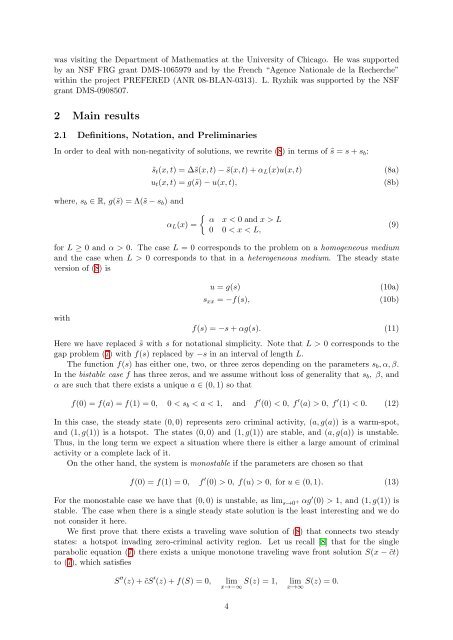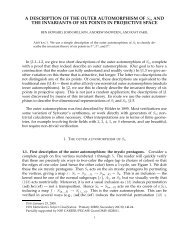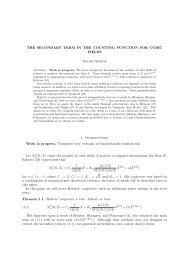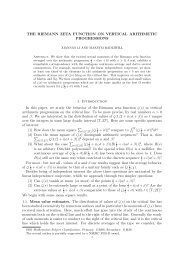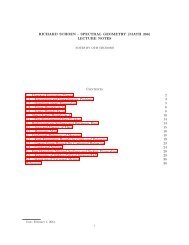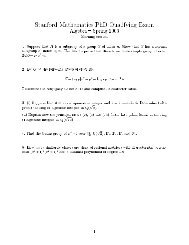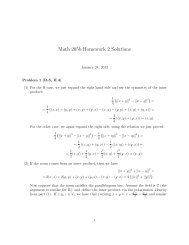Traveling Wave Solutions in a Reaction-Diffusion Model for Criminal ...
Traveling Wave Solutions in a Reaction-Diffusion Model for Criminal ...
Traveling Wave Solutions in a Reaction-Diffusion Model for Criminal ...
Create successful ePaper yourself
Turn your PDF publications into a flip-book with our unique Google optimized e-Paper software.
was visit<strong>in</strong>g the Department of Mathematics at the University of Chicago. He was supported<br />
by an NSF FRG grant DMS-1065979 and by the French “Agence Nationale de la Recherche”<br />
with<strong>in</strong> the project PREFERED (ANR 08-BLAN-0313). L. Ryzhik was supported by the NSF<br />
grant DMS-0908507.<br />
2 Ma<strong>in</strong> results<br />
2.1 Def<strong>in</strong>itions, Notation, and Prelim<strong>in</strong>aries<br />
In order to deal with non-negativity of solutions, we rewrite (8) <strong>in</strong> terms of ˜s = s + sb:<br />
where, sb ∈ R, g(˜s) = Λ(˜s − sb) and<br />
˜st(x, t) = ∆˜s(x, t) − ˜s(x, t) + αL(x)u(x, t) (8a)<br />
ut(x, t) = g(˜s) − u(x, t), (8b)<br />
αL(x) =<br />
α x < 0 and x > L<br />
0 0 < x < L,<br />
<strong>for</strong> L ≥ 0 and α > 0. The case L = 0 corresponds to the problem on a homogeneous medium<br />
and the case when L > 0 corresponds to that <strong>in</strong> a heterogeneous medium. The steady state<br />
version of (8) is<br />
with<br />
(9)<br />
u = g(s) (10a)<br />
sxx = −f(s), (10b)<br />
f(s) = −s + αg(s). (11)<br />
Here we have replaced ˜s with s <strong>for</strong> notational simplicity. Note that L > 0 corresponds to the<br />
gap problem (7) with f(s) replaced by −s <strong>in</strong> an <strong>in</strong>terval of length L.<br />
The function f(s) has either one, two, or three zeros depend<strong>in</strong>g on the parameters sb, α, β.<br />
In the bistable case f has three zeros, and we assume without loss of generality that sb, β, and<br />
α are such that there exists a unique a ∈ (0, 1) so that<br />
f(0) = f(a) = f(1) = 0, 0 < sb < a < 1, and f ′ (0) < 0, f ′ (a) > 0, f ′ (1) < 0. (12)<br />
In this case, the steady state (0, 0) represents zero crim<strong>in</strong>al activity, (a, g(a)) is a warm-spot,<br />
and (1, g(1)) is a hotspot. The states (0, 0) and (1, g(1)) are stable, and (a, g(a)) is unstable.<br />
Thus, <strong>in</strong> the long term we expect a situation where there is either a large amount of crim<strong>in</strong>al<br />
activity or a complete lack of it.<br />
On the other hand, the system is monostable if the parameters are chosen so that<br />
f(0) = f(1) = 0, f ′ (0) > 0, f(u) > 0, <strong>for</strong> u ∈ (0, 1). (13)<br />
For the monostable case we have that (0, 0) is unstable, as lim s→0 + αg ′ (0) > 1, and (1, g(1)) is<br />
stable. The case when there is a s<strong>in</strong>gle steady state solution is the least <strong>in</strong>terest<strong>in</strong>g and we do<br />
not consider it here.<br />
We first prove that there exists a travel<strong>in</strong>g wave solution of (8) that connects two steady<br />
states: a hotspot <strong>in</strong>vad<strong>in</strong>g zero-crim<strong>in</strong>al activity region. Let us recall [8] that <strong>for</strong> the s<strong>in</strong>gle<br />
parabolic equation (7) there exists a unique monotone travel<strong>in</strong>g wave front solution S(x − ˜ct)<br />
to (7), which satisfies<br />
S ′′ (z) + ˜cS ′ (z) + f(S) = 0, lim S(z) = 1, lim S(z) = 0.<br />
x→−∞ x→∞<br />
4


